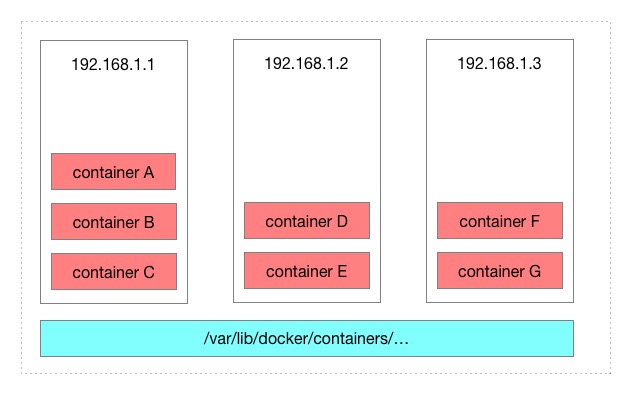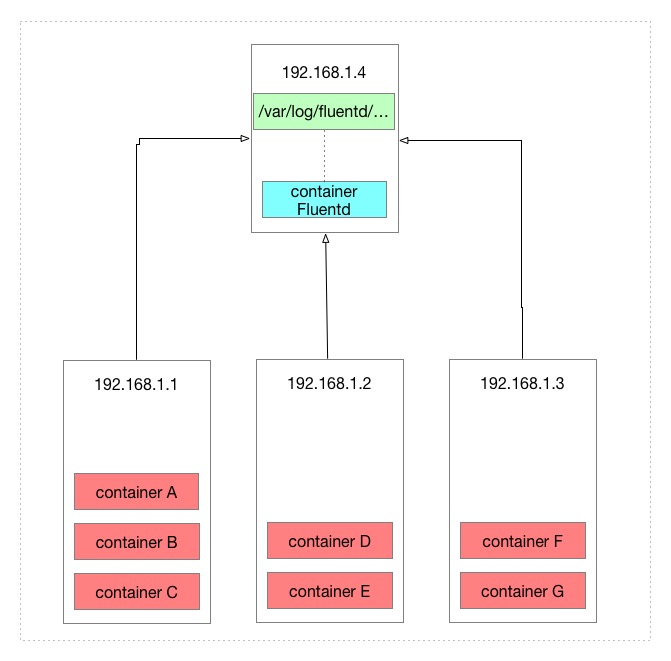您好,登錄后才能下訂單哦!
您好,登錄后才能下訂單哦!
這篇文章主要講解了“如何使用fluentd作為docker日志驅動收集日志”,文中的講解內容簡單清晰,易于學習與理解,下面請大家跟著小編的思路慢慢深入,一起來研究和學習“如何使用fluentd作為docker日志驅動收集日志”吧!
docker默認的日志驅動是json-file,每一個容器都會在本地生成一個/var/lib/docker/containers/containerID/containerID-json.log,而日志驅動是支持擴展的,本章主要講解的是Fluentd驅動收集docker日志.
Fluentd是用于統一日志記錄層的開源數據收集器,是繼Kubernetes、Prometheus、Envoy 、CoreDNS 和containerd后的第6個CNCF畢業項目,常用來對比的是elastic的logstash,相對而言fluentd更加輕量靈活,現在發展非常迅速社區很活躍,在編寫這篇blog的時候github的star是8.8k,fork是1k就可見一斑.
docker
了解fluentd配置
docker-compose
docker-compose.yml
version: '3.7'
x-logging:
&default-logging
driver: fluentd
options:
fluentd-address: localhost:24224
fluentd-async-connect: 'true'
mode: non-blocking
max-buffer-size: 4m
tag: "kafeidou.{{.Name}}" #配置容器的tag,以kafeidou.為前綴,容器名稱為后綴,docker-compose會給容器添加副本后綴,如 fluentd_1
services:
fluentd:
image: fluent/fluentd:v1.3.2
ports:
- 24224:24224
volumes:
- ./:/fluentd/etc
- /var/log/fluentd:/var/log/fluentd
environment:
- FLUENTD_CONF=fluentd.conf
fluentd-worker:
image: fluent/fluentd:v1.3.2
depends_on:
- fluentd
logging: *default-loggingfluentd.conf
<source>
@type forward
port 24224
bind 0.0.0.0
</source>
<match kafeidou.*>
@type file
path /var/log/fluentd/kafeidou/${tag[1]}
append true
<format>
@type single_value
message_key log
</format>
<buffer tag,time>
@type file
timekey 1d
timekey_wait 10m
flush_mode interval
flush_interval 5s
</buffer>
</match>
<match **>
@type file
path /var/log/fluentd/${tag}
append true
<format>
@type single_value
message_key log
</format>
<buffer tag,time>
@type file
timekey 1d
timekey_wait 10m
flush_mode interval
flush_interval 5s
</buffer>
</match>由于fluentd需要在配置的目錄中有寫入的權限,所以需要先準備好存放log的目錄以及給予權限.
創建目錄
mkdir /var/log/fluentd
給予權限,這里用于實驗演示,直接授權777
chmod -R 777 /var/log/fluentd
在docker-compose.yml和fluentd.conf的目錄中執行命令:
docker-compose up -d
[root@master log]# docker-compose up -d WARNING: The Docker Engine you're using is running in swarm mode. Compose does not use swarm mode to deploy services to multiple nodes in a swarm. All containers will be scheduled on the current node. To deploy your application across the swarm, use `docker stack deploy`. Creating network "log_default" with the default driver Creating fluentd ... done Creating fluentd-worker ... done
查看一下日志目錄下,應該就有對應的容器日志文件了:
[root@master log]# ls /var/log/fluentd/kafeidou/
fluentd-worker.20200215.log ${tag[1]}這是我最后的一個實驗結果,會創建一個${tag[1]}目錄,挺奇怪的,而且在這個目錄下還會有兩個文件
[root@master log]# ls /var/log/fluentd/kafeidou/\$\{tag\[1\]\}/
buffer.b59ea0804f0c1f8b6206cf76aacf52fb0.log buffer.b59ea0804f0c1f8b6206cf76aacf52fb0.log.meta如果有明白這塊的也歡迎一起交流!
我們先看一下原始的docker日志是怎么樣一個架構:

docker會在本機的/var/lib/docker/containers/containerID/containerID-json.log路徑為每一個容器生成一個log文件,存儲docker的日志.
上圖中總共有7個容器,當成7個微服務的話,在需要查看日志的時候就已經很不方便了,最差情況需要分別在三臺機器上查看每一個容器的日志.
使用fluentd收集docker日志后可以將容器匯總到一起.來看看配置了本文的fluentd配置文件后的架構:

由于fluentd配置的是存儲在fluentd所在機器的本地目錄,所以效果是將其他機器的容器日志收集到fluentd所在機器的本地目錄中.
fluentd實際上可以將收集到的日志再次傳輸出去,例如傳輸到elasticsearch等存儲軟件中:

fluentd能做的事情還有很多,fluentd本身能作為傳輸節點也能作為接受節點,還能夠過濾特定日志,格式化特定內容的日志,將匹配的特定日志再次傳輸出去,這里只是做到一個簡單的收集docker容器日志的效果.
感謝各位的閱讀,以上就是“如何使用fluentd作為docker日志驅動收集日志”的內容了,經過本文的學習后,相信大家對如何使用fluentd作為docker日志驅動收集日志這一問題有了更深刻的體會,具體使用情況還需要大家實踐驗證。這里是億速云,小編將為大家推送更多相關知識點的文章,歡迎關注!
免責聲明:本站發布的內容(圖片、視頻和文字)以原創、轉載和分享為主,文章觀點不代表本網站立場,如果涉及侵權請聯系站長郵箱:is@yisu.com進行舉報,并提供相關證據,一經查實,將立刻刪除涉嫌侵權內容。